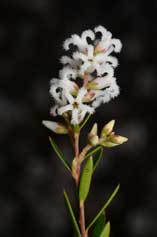In Flower This Week
A news sheet prepared by a Gardens' volunteer.
Numbers before each plant refer to temporary IFTW labels in the gardens.
Numbers in square brackets [ ] refer to garden bed Sections. Plants in flower are in bold type.
View past issues of 'In Flower This Week'.
19 August 2015
Leucopogon melaleucoides click for larger image |
This week it is time to focus on our wonderful wattles.
- Just before the bridge to the café see on your right Acacia myrtifolia [Section 174], an interesting and unusual wattle that has bright red new growth and stems with green elliptical phyllodes (modified leaf-stems) and cream balls of flowers. It is often called the Red-stemmed Wattle or Myrtle Wattle. It is found in all six Australian states. Now bear left up the hill behind the café.
- Further on the right is Acacia siculiformis [Section 128], a very stiff, upright shrub with pointed, dark green phyllodes and cream balls of flowers. It is native to New South Wales, the Australian Capital Territory, Victoria and Tasmania.
- Bear right to see on your right Acacia podalyriifolia [Section 126], or Queensland Silver Wattle, with large golden balls of flowers and attractive grey-green foliage. It is a fast-growing small tree widely cultivated in Australia and also naturalised overseas.
- Turn left up the hill and continue along the path to see on the left Leucopogon melaleucoides [Section 110] or Snowbush, a small compact shrub with dark green foliage and white clusters of flowers. It is native to the Granite Belt near Stanthorpe in Queensland. The photo above shows it in full bloom. Turn right along the Main Path.
- Turn left up the steps to see Acacia amoena [Section 3], or Boomerang Wattle, on your left. It is a small spreading shrub with tough yellow-green leaves and golden balls of flowers. It is native to New South Wales and northern Victorian tablelands.
- Further up the hill on your left is Acacia covenyi [Section 3], commonly known as Blue Bush. This small tree has magnificent silver-grey foliage and masses of contrasting bright gold flower balls. It is a rare plant in the wild, being confined to southern New South Wales.
- Across the road on your right is Acacia parvipinnula [Section 18], or Silver-stemmed Wattle, which is a tree with dark green ferny foliage and pale yellow balls of flower.
- Further on your left is Acacia oshanesii [Section 3], native to coastal New South Wales and Queensland. This tree has fine dark-green divided foliage with fluffy yellow ball flowers.
- Again on your left is Acacia caesiella [Section 3], from the central slopes of New South Wales. It forms a low spreading shrub with grey-green linear foliage and yellow balls of flower.
- Bear right along the edge of the Eucalypt Lawn to see on your right Acacia cardiophylla [Section 18], or West Wyalong Wattle, with ferny, light green bipinnate foliage and masses of yellow balls of flower. It occurs in the wild in central and southern New South Wales.
- Still on your right is Acacia parvifolia [Section 18], with soft grey fringed foliage and pale yellow balls of flowers.
- Acacia baileyana [Section 18], on the left , commonly known as Cootamundra Wattle, is a shrub native to southern New South Wales. It has silver-grey feathery foliage and yellow balls of flowers.
- On your left is Acacia boormanii [Section 18] or Snowy River Wattle with fine needle foliage and masses of golden ball flowers. It is a medium-sized, suckering, multi-stemmed, shrub, with a native range in the alpine country of south eastern Australia.
- Acacia consobrina [Section 18], is on your left, native to southwestern Western Australia. It is a low spreading shrub with grey foliage and large gold ball flowers.
- Acacia venulosa [Section 18] is further along on your left with green linear foliage and bright yellow balls of flowers. It is native to northern coastal and tablelands New South Wales and south-eastern Queensland, especially in the Stanthorpe area.
Rosalind Walcott
![Director of National Parks [logo]](../../../../images/dnp_90px.gif)







